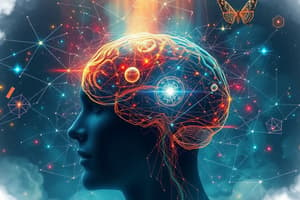Podcast
Questions and Answers
Which of the following processes has begun as soon as special receptor cells for the senses are activated?
Which of the following processes has begun as soon as special receptor cells for the senses are activated?
- Habituation
- Sublimination
- Perception
- Adaptation
- Sensation (correct)
Which of the following begins at the sensory receptors and builds to higher levels of processing?
Which of the following begins at the sensory receptors and builds to higher levels of processing?
- Top-down processing
- Top-up processing
- Bottom-up processing (correct)
- Bottom-down processing
- Perception
What is the process by which physical sensations are converted into neural messages?
What is the process by which physical sensations are converted into neural messages?
Transduction
What is the smallest difference between two stimuli that can be detected called?
What is the smallest difference between two stimuli that can be detected called?
The reality that stress increases your sensitivity to faint pain stimuli is important to a student's understanding of?
The reality that stress increases your sensitivity to faint pain stimuli is important to a student's understanding of?
What is the tendency of sensory receptor cells to become less responsive to a stimulus that is unchanging called?
What is the tendency of sensory receptor cells to become less responsive to a stimulus that is unchanging called?
In a scenario where someone becomes less aware of a smell over time, what is this an example of?
In a scenario where someone becomes less aware of a smell over time, what is this an example of?
What is it called when someone fails to retain auditory information due to focus elsewhere?
What is it called when someone fails to retain auditory information due to focus elsewhere?
Explain how perceptual sets change our perceptions.
Explain how perceptual sets change our perceptions.
What is the protective covering of the eye through which light first enters?
What is the protective covering of the eye through which light first enters?
The opponent-process theory states that color vision is the result of opposing retinal processing. Red is paired with ______________ and yellow is paired with ______________.
The opponent-process theory states that color vision is the result of opposing retinal processing. Red is paired with ______________ and yellow is paired with ______________.
What determines the color you see?
What determines the color you see?
What is the function of the lens in the eye?
What is the function of the lens in the eye?
The __________ is the muscle that responds to light intensity by dilating or constricting.
The __________ is the muscle that responds to light intensity by dilating or constricting.
Cones are to ______________ vision as rods are to ______________ vision.
Cones are to ______________ vision as rods are to ______________ vision.
When light moves through the lens in the eye, the representation is flipped and inverted. The flipped image is projected onto which part of the eye?
When light moves through the lens in the eye, the representation is flipped and inverted. The flipped image is projected onto which part of the eye?
Which of the following shows the steps of visual processing in the correct order?
Which of the following shows the steps of visual processing in the correct order?
What does it mean to be 'colorblind'?
What does it mean to be 'colorblind'?
What produces the 'blind spot'?
What produces the 'blind spot'?
Which group of psychologists suggested that the 'whole' exceeds the sum of its parts?
Which group of psychologists suggested that the 'whole' exceeds the sum of its parts?
A newborn baby does not possess the ability to perceive the world in three dimensions. This develops early in infancy. The newborn baby lacks ______________.
A newborn baby does not possess the ability to perceive the world in three dimensions. This develops early in infancy. The newborn baby lacks ______________.
The tendency to perceive the apparent brightness of an object as the same, even when the light conditions change, is known as?
The tendency to perceive the apparent brightness of an object as the same, even when the light conditions change, is known as?
What do we call the difference seen by each eye for objects that are close in the visual field?
What do we call the difference seen by each eye for objects that are close in the visual field?
Railroad tracks appear to narrow as they...?
Railroad tracks appear to narrow as they...?
Flashcards
Sensation
Sensation
The process that starts when specialized receptor cells in our senses are activated.
Perception
Perception
The process where information from sensory receptors is processed by the brain and organized into meaningful perceptions. It moves from simple sensory input to complex interpretations.
Bottom-up processing
Bottom-up processing
Information processing that begins with sensory receptors and moves to higher levels of processing in the brain. In other words, it's the process of building a perception from the bottom up, starting with basic sensory information.
Transduction
Transduction
Signup and view all the flashcards
Difference threshold
Difference threshold
Signup and view all the flashcards
Signal detection theory
Signal detection theory
Signup and view all the flashcards
Sensory adaptation
Sensory adaptation
Signup and view all the flashcards
Cocktail party effect
Cocktail party effect
Signup and view all the flashcards
Perceptual set
Perceptual set
Signup and view all the flashcards
Cornea
Cornea
Signup and view all the flashcards
Opponent-process theory
Opponent-process theory
Signup and view all the flashcards
Color perception
Color perception
Signup and view all the flashcards
Lens
Lens
Signup and view all the flashcards
Iris
Iris
Signup and view all the flashcards
Cones
Cones
Signup and view all the flashcards
Rods
Rods
Signup and view all the flashcards
Retina
Retina
Signup and view all the flashcards
Visual processing
Visual processing
Signup and view all the flashcards
Colorblindness
Colorblindness
Signup and view all the flashcards
Blind spot
Blind spot
Signup and view all the flashcards
Gestalt psychology
Gestalt psychology
Signup and view all the flashcards
Depth perception
Depth perception
Signup and view all the flashcards
Brightness constancy
Brightness constancy
Signup and view all the flashcards
Retinal disparity
Retinal disparity
Signup and view all the flashcards
Railroad tracks illusion
Railroad tracks illusion
Signup and view all the flashcards
Study Notes
Sensation and Perception
- Sensation is the process initiated by activation of special receptor cells for the senses.
- Bottom-up processing begins at sensory receptors, building to higher levels of processing.
- Transduction is the conversion of physical sensations into neural messages for perception.
- Difference threshold refers to the smallest detectable difference between two stimuli.
Theories and Concepts
- Signal detection theory explains how stress can increase sensitivity to faint pain stimuli.
- Sensory adaptation occurs when sensory receptor cells become less responsive to unchanging stimuli.
- The cocktail party effect describes the ability to focus on a single conversation in a noisy environment while filtering out other sounds.
Perception Influences
- Perceptual sets influence how individuals interpret stimuli based on expectations and context, leading to subjective experiences.
- Example: One person might see a bunny in clouds while another sees a flower, showcasing different interpretations of the same visual stimulus.
Visual System Anatomy and Function
- The cornea is the protective covering of the eye where light first enters.
- The opponent-process theory posits opposing retinal processing for colors; red vs. green and yellow vs. blue.
- Color perception is dependent on the length of the light wave.
Eye Components
- The lens changes shape to focus objects on the retina.
- The iris adjusts light intensity by dilating or constricting.
- Cones are responsible for color vision, while rods are connected to black and white vision.
- The retina receives an inverted image when light passes through the lens.
Visual Processing and Perception
- Visual processing steps include gathering light, in-eye processing, transduction, and brain processing.
- Colorblindness arises from a lack of red-sensitive or green-sensitive cones.
- The blind spot occurs due to the absence of receptor cells where the optic nerve exits the eye.
Gestalt Psychology and Depth Perception
- Gestalt psychologists argue that the "whole" perception is greater than the sum of its parts.
- Newborns initially lack depth perception, which develops during infancy.
- Brightness constancy ensures the perceived brightness of an object remains consistent despite changes in light.
Retinal Disparity
- Retinal disparity describes the difference in images seen by each eye; it's larger for nearby objects and smaller for distant ones.
Additional Visual Illusions
- Railroad tracks illustrate an optical illusion where they appear to converge as they extend into the distance.
Studying That Suits You
Use AI to generate personalized quizzes and flashcards to suit your learning preferences.




